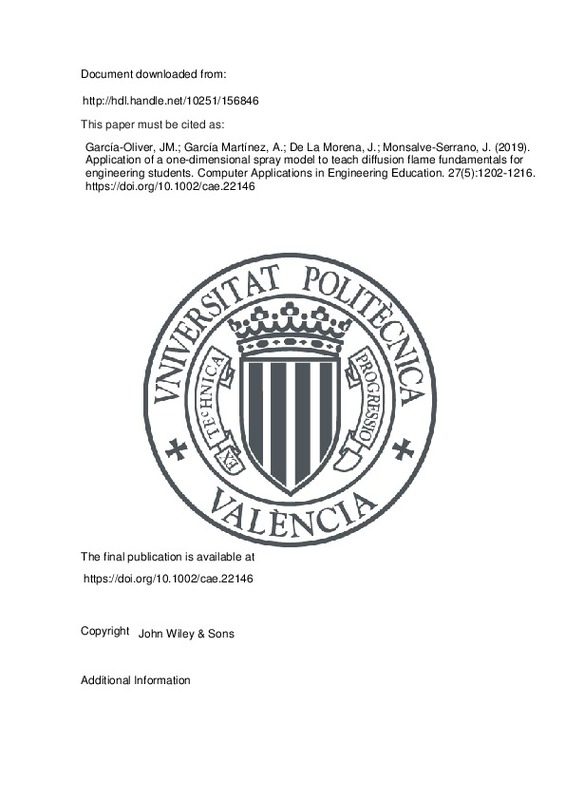Aleiferis, P. G., Behringer, M. K., & Malcolm, J. S. (2016). Integral Length Scales and Time Scales of Turbulence in an Optical Spark-Ignition Engine. Flow, Turbulence and Combustion, 98(2), 523-577. doi:10.1007/s10494-016-9775-9
Battin-Leclerc, F. (2008). Detailed chemical kinetic models for the low-temperature combustion of hydrocarbons with application to gasoline and diesel fuel surrogates. Progress in Energy and Combustion Science, 34(4), 440-498. doi:10.1016/j.pecs.2007.10.002
Burke, R. D., De Jonge, N., Avola, C., & Forte, B. (2017). A virtual engine laboratory for teaching powertrain engineering. Computer Applications in Engineering Education, 25(6), 948-960. doi:10.1002/cae.21847
[+]
Aleiferis, P. G., Behringer, M. K., & Malcolm, J. S. (2016). Integral Length Scales and Time Scales of Turbulence in an Optical Spark-Ignition Engine. Flow, Turbulence and Combustion, 98(2), 523-577. doi:10.1007/s10494-016-9775-9
Battin-Leclerc, F. (2008). Detailed chemical kinetic models for the low-temperature combustion of hydrocarbons with application to gasoline and diesel fuel surrogates. Progress in Energy and Combustion Science, 34(4), 440-498. doi:10.1016/j.pecs.2007.10.002
Burke, R. D., De Jonge, N., Avola, C., & Forte, B. (2017). A virtual engine laboratory for teaching powertrain engineering. Computer Applications in Engineering Education, 25(6), 948-960. doi:10.1002/cae.21847
Desantes, J. M., Pastor, J. V., García-Oliver, J. M., & Briceño, F. J. (2014). An experimental analysis on the evolution of the transient tip penetration in reacting Diesel sprays. Combustion and Flame, 161(8), 2137-2150. doi:10.1016/j.combustflame.2014.01.022
Desantes, J. M., Pastor, J. V., García-Oliver, J. M., & Pastor, J. M. (2009). A 1D model for the description of mixing-controlled reacting diesel sprays. Combustion and Flame, 156(1), 234-249. doi:10.1016/j.combustflame.2008.10.008
Dumouchel, C., Cousin, J., & Triballier, K. (2005). On the role of the liquid flow characteristics on low-Weber-number atomization processes. Experiments in Fluids, 38(5), 637-647. doi:10.1007/s00348-005-0944-1
Edmonds, E. (1980). Where Next in Computer Aided Learning? British Journal of Educational Technology, 11(2), 97-104. doi:10.1111/j.1467-8535.1980.tb00396.x
Fansler, T. D., & Parrish, S. E. (2014). Spray measurement technology: a review. Measurement Science and Technology, 26(1), 012002. doi:10.1088/0957-0233/26/1/012002
Gutiérrez-Romero, J. E., Zamora-Parra, B., & Esteve-Pérez, J. A. (2016). Acquisition of offshore engineering design skills on naval architecture master courses through potential flow CFD tools. Computer Applications in Engineering Education, 25(1), 48-61. doi:10.1002/cae.21778
IPCC. Intergovernmental Panel on Climate Change Working Group I. Climate Change 2013: The Physical Science Basis.Long‐term Climate Change: Projections Commitments and Irreversibility Cambridge University Press New York NY 2013:1029–136.https://doi.org/10.1017/CBO9781107415324.024
W. Kirchstetter, T., Harley, R. A., Kreisberg, N. M., Stolzenburg, M. R., & Hering, S. V. (1999). On-road measurement of fine particle and nitrogen oxide emissions from light- and heavy-duty motor vehicles. Atmospheric Environment, 33(18), 2955-2968. doi:10.1016/s1352-2310(99)00089-8
K. BenNaceur L.Cozzi andT.Gould.World Energy Outlook 2016.2016.https://doi.org/10.1787/weo‐2016‐en
M.Nesbitet al. Comparative Study on the differences between the EU and US legislation on emissions in the automotive sector.2016.
PASTOR, J., JAVIERLOPEZ, J., GARCIA, J., & PASTOR, J. (2008). A 1D model for the description of mixing-controlled inert diesel sprays. Fuel, 87(13-14), 2871-2885. doi:10.1016/j.fuel.2008.04.017
PAYRI, R., GARCIA, J., SALVADOR, F., & GIMENO, J. (2005). Using spray momentum flux measurements to understand the influence of diesel nozzle geometry on spray characteristics. Fuel, 84(5), 551-561. doi:10.1016/j.fuel.2004.10.009
Payri, R., Salvador, F. J., Gimeno, J., & Novella, R. (2011). Flow regime effects on non-cavitating injection nozzles over spray behavior. International Journal of Heat and Fluid Flow, 32(1), 273-284. doi:10.1016/j.ijheatfluidflow.2010.10.001
Perumal, K., & Ganesan, R. (2015). CFD modeling for the estimation of pressure loss coefficients of pipe fittings: An undergraduate project. Computer Applications in Engineering Education, 24(2), 180-185. doi:10.1002/cae.21695
Regueiro, A., Patiño, D., Míguez, C., & Cuevas, M. (2017). A practice for engineering students based on the control and monitoring an experimental biomass combustor using labview. Computer Applications in Engineering Education, 25(3), 392-403. doi:10.1002/cae.21806
Sick, V., Drake, M. C., & Fansler, T. D. (2010). High-speed imaging for direct-injection gasoline engine research and development. Experiments in Fluids, 49(4), 937-947. doi:10.1007/s00348-010-0891-3
SPALDING, D. B. (1979). The stability of steady exothermic chemical reactions in simple non-adiabatic systems. Combustion and Mass Transfer, 399-406. doi:10.1016/b978-0-08-022106-9.50025-5
Weilenmann, M., Soltic, P., Saxer, C., Forss, A.-M., & Heeb, N. (2005). Regulated and nonregulated diesel and gasoline cold start emissions at different temperatures. Atmospheric Environment, 39(13), 2433-2441. doi:10.1016/j.atmosenv.2004.03.081
www.upv.es. Universitat Politècnica de València.
Zhao, H., & Ladommatos, N. (1998). Optical diagnostics for soot and temperature measurement in diesel engines. Progress in Energy and Combustion Science, 24(3), 221-255. doi:10.1016/s0360-1285(97)00033-6
[-]







![[Cerrado]](/themes/UPV/images/candado.png)


